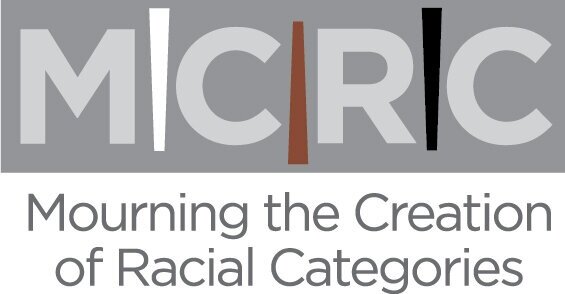Which question does Grouping G answer? (answer key at bottom of page)
1. In the United States, how do we determine who is black and who is white?
2. How did white become the free and black the enslaved?
3. White is “the standard.” What does that mean?
4. Why White?
5. When words are inadequate, how can the arts help us feel the emotions of race?
6. If you do not identify as black or white, where do you fit into the conversation about race?
7. How did white become the pure category and black the contaminating one?
Artwork by Jessica Holtman and Tabitha Kelly. Commissioned by the MCRC Project.
three servants run away together
In 1640, the Virginia General Court decided the punishments for three servants who ran away together from their master: “The court doth therefore order that the said three servants shall receive the punishment of whipping and to have thirty stripes (or lashes) apiece. The Dutchman (Victor) and Scot (Gregory) shall have four years added to their terms of servitude. The third being a negro named John Punch shall serve his said master for the time of his natural life.”
How would such drastically different punishments for the same crime impact friendships?
One Is Enslaved for Life
John Punch is the first documented person in the English colonies to be sentenced to enslavement for life. Handed down in 1640, his sentence marks the start of the Terrible Transformation—the process by which enslavement was imposed specifically on African peoples and their descendants.
Artwork by Kevin Muente. Commissioned by the MCRC Project.
Artwork by Carly Strohmaier. Commissioned by the MCRC Project.
Terrible Transformation
The boats visualize the Terrible Transformation. The top row depicts the relative numbers of laborers by geographic source (1607-1732). Note, the laborers from Europe and indigenous lands far outnumbered those from Africa.
The bottom row depicts the relative number of laborers by geographic source (1732 to 1808). Note, the laborers from Africa far outnumbered those from both Europe and indigenous lands. The reversals are striking.
The pool of indentured labor shrunk for many reasons: (1) a catastrophic fire destroyed much of London, giving unemployed people the opportunity to stay at home and work as laborers to rebuild the city; (2) the bubonic plague struck around this same time, killing an estimated 25% of England’s population; (3) Britain, also in need of laborers, outlawed deceptive recruiting practices; and (4) during the American Revolutionary War (1775 to 1783), the U.S. prohibited enemy British ships carrying indentured labor from entering its ports.
Major reasons for the decline in Indigenous enslaved included exposure to deadly epidemic diseases and genocide carried out through warfare and removal from their land. Because Indigenous peoples knew the land so well, the enslaved among them had a better chance of escaping servitude. For this reason, the English shipped many Indigenous peoples off to sugar plantations in the Caribbean or the West Indies where surroundings were unfamiliar, making attempts to escape less likely.
Records show that between 1619 and 1675, about 4,000 Africans were forced into bondage. As forced labor from Indigenous and European populations declined, the reliance on enslaved labor from the African continent increased dramatically. Beginning in the 1680s and for the next 128 years (until 1808, when the practice of importing, but not enslaving, people became illegal in the U.S.), 386,000 Africans were forcibly transported across the Atlantic Ocean to the United States. The enslaved women among them would become the mothers, grandmothers, and great grandmothers of 3.9 million enslaved peoples of African descent living in the U.S. on the brink of the Civil War (1861–1865).
Artwork by Tabitha Kelly. Commissioned by the MCRC Project.
Condition of the Mother Laws
Enslaved women were subjected to the Condition of the Mother laws. One law of 1662 stated: “All children born in this country shall be held slave or free depending on the condition of the mother.” This law guaranteed a perpetual supply of bodies for free labor.
Notice that the women’s skin differs in shades. Also notice that some babies appear to be a different race than the mother carrying them. Regardless, her babies followed her condition. If the mother was enslaved, her baby was enslaved.
The Fathers Could Not Matter
The Condition of the Mother law disregarded the status of the biological father in determining a baby’s fate. The father could be enslaved, indentured, free, or the mother’s own master. In other words, an enslaved woman’s master owned any babies born to her. These laws tied the fate of a baby to the fate of its mother and were the engine driving intergenerational enslavement.
Illustration by Tabitha Kelly. Commissioned by the MCRC Project.
answer key
grouping g answers question 2
How did white become the free and black the enslaved?






